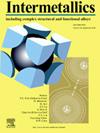热处理 ZrNbTiVAl 高熵合金在干燥滑动条件下的摩擦学特性研究
IF 4.3
2区 材料科学
Q2 CHEMISTRY, PHYSICAL
引用次数: 0
摘要
本研究探讨了新开发的 ZrNbTiVAl 高熵合金(HEA)的摩擦学性能与热处理引起的微观结构变化之间的关系。对合金的铸造状态和在 950 °C、15、20 和 25 小时的热处理后进行了评估,并对氧化铝球面进行了干滑动实验。研究采用了先进的分析技术,包括三维光学轮廓仪、纳米硬度测试、场发射扫描电子显微镜(FESEM)、能量色散光谱仪(EDS)和显微拉曼光谱仪,以进行全面的表面分析,并研究磨损表面氧化层的形成。增加 950 ℃ 热处理持续时间可提高 ZrNbTiVAl 高熵合金 (HEA) 的硬度(H)并降低弹性模量(E)。值得注意的是,与 20 小时和 25 小时热处理状态相比,尽管 H/E 和 H³/E2 值较低,但铸造状态和 15 小时热处理状态下的磨损率和摩擦力较低。此外,磨损机理也发生了显著变化,从原样浇铸和 15 小时热处理状态下的轻度粘附/氧化磨损转变为 20 小时和 25 小时热处理状态下的严重粘附/氧化磨损。铸态和 15 h 条件下的性能改善归因于 Ti 和 V 元素的富集--这两种元素具有公认的固体润滑特性--以及 Al-Zr 金属间化合物的减少,这有助于最大限度地减少干滑动过程中硬质磨损碎片的形成。这些发现强调了优化热处理参数以获得优异摩擦学性能的重要性。本文章由计算机程序翻译,如有差异,请以英文原文为准。
Investigation of tribological properties of heat-treated ZrNbTiVAl high entropy alloy in dry sliding conditions
This study explored the relationship between tribological performance and microstructural changes induced by heat treatment in a newly developed ZrNbTiVAl high-entropy alloy (HEA). The alloy was evaluated in its as-cast state and after heat treatments at 950 °C for 15, 20, and 25 h, with dry sliding experiments conducted against an alumina ball counterface. Advanced analytical techniques, including 3D optical profilometry, nanohardness testing, field emission scanning electron microscopy (FESEM), energy-dispersive spectroscopy (EDS), and Micro-Raman spectroscopy, were employed for comprehensive surface analysis and to investigate oxide layer formation on the worn surfaces.
The study reveals a nuanced relationship between heat treatment duration, oxide layer formation, and frictional behavior in the ZrNbTiVAl high-entropy alloy (HEA). Increasing the heat treatment duration at 950 °C results in higher hardness (H) and a reduction in the modulus of elasticity (E) of the ZrNbTiVAl high-entropy alloy (HEA). Notably, wear rate and friction were lower in the as-cast and 15 h heat-treated conditions, despite their lower H/E and H³/E2 values compared to the 20 h and 25 h heat-treated states. Additionally, the wear mechanisms shift significantly, from mild adhesive/oxidative wear in the as-cast and 15 h conditions to severe adhesive/oxidative wear in the 20 h and 25 h conditions. This improved performance in the as-cast and 15 h conditions is attributed to the enrichment of Ti and V—elements recognized for their solid lubrication properties—and a reduced presence of Al-Zr intermetallics, which helps to minimize the formation of hard wear debris during dry sliding. These findings underscore the importance of optimizing heat treatment parameters to achieve superior tribological performance.
求助全文
通过发布文献求助,成功后即可免费获取论文全文。
去求助
来源期刊

Intermetallics
工程技术-材料科学:综合
CiteScore
7.80
自引率
9.10%
发文量
291
审稿时长
37 days
期刊介绍:
This journal is a platform for publishing innovative research and overviews for advancing our understanding of the structure, property, and functionality of complex metallic alloys, including intermetallics, metallic glasses, and high entropy alloys.
The journal reports the science and engineering of metallic materials in the following aspects:
Theories and experiments which address the relationship between property and structure in all length scales.
Physical modeling and numerical simulations which provide a comprehensive understanding of experimental observations.
Stimulated methodologies to characterize the structure and chemistry of materials that correlate the properties.
Technological applications resulting from the understanding of property-structure relationship in materials.
Novel and cutting-edge results warranting rapid communication.
The journal also publishes special issues on selected topics and overviews by invitation only.
 求助内容:
求助内容: 应助结果提醒方式:
应助结果提醒方式:


